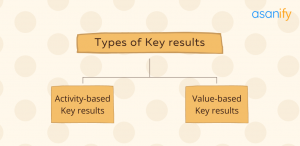We keep hearing the term OKR a lot. But, very often look at it as one vast concept. Today, we’re going to deep dive into key results and how you can optimise each key result to boost employee performance!
In this blog, I will cover the following things,
- What is a Key result?
- What is an OKR
- Benefits of having a Key result
- Factors to consider while writing a Key result
- Types of Key Results
- Examples of good Key result Areas
- Tracking a Key result area using Asanify
- Summary
- FAQs
What is a Key result?
A key result is basically a component of OKR. We’ll come to what an OKR as a whole is, but first, let us understand the basis of what forms a key result.
Key Results are the different factors you look at to measure how much of your objective you have achieved. Every time you sent an objective for yourself (or your team), you need to have a group of key results that help you achieve that objective.
But how do you formulate a set of key results?
When you set a goal or an objective, try thinking of the top 3-5 major factors that will play a role in you (or your team) achieving that goal. Using those top 3-5 factors, you can then form each key result.
Sounds simple right? Let’s look at the basic aspects of an OKR and the benefits of using Key results before you start writing them!
What is an OKR
First things first, OKR stands for Objective and key results. It is a tool that is used to communicate what you want to accomplish and what milestones or other factors play in role in helping you in order to accomplish the objective faster.
You can set OKRs for individuals in a team, for an entire team or even for a company at large.
In this blog, I will only focus on the key result aspect of an OKR, but if you want a deeper understanding of what OKR means and how the concept can help you, click here to read our blog on OKR
Download a role-based and comprehensive list of OKR examples, for FREE!
Benefits of having a Key result
There are various benefits of using key results in your organization. Some of them are listed below!
Alignment of company-wide objectives with each employee
Very often, companies struggle to align the goals and objectives of each employee with that of the larger organization. Employees can feel stuck in one place or bored in their jobs if they don’t realise the impact of their own work on the organization.
OKR helps with this problem. When you set OKRs for a company, they can easily cascade down to each employee within each team of your business Thus, each employee is aligned with the business objectives. Each objective will come with a fixed set of key results (which we are talking about in this blog), to help employees perform better.
Key results help track the performance at every level in the organization
The most important aspect of a key result is that it is measurable!
So, at every step of the way, you can check in with an employee to see how much of an objective has been accomplished and how much is left. And this works in the same way for an employee who is at the bottom of the ranking or even someone in top management. As a result, it becomes extremely easy to track performance across the company.
Helps make informed decisions based on real-time data and insights
Let me explain this one with an example.
In an organization, you aren’t onboarding as many new clients as would like on a monthly basis. You go back to your sales representatives and ask them why they haven’t been making the target number of outbound calls. In return, they tell you that they have in reality been making 120% of the required number of calls. You then realise that while the outbound calls are may, the conversion rate is extremely poor! That is when you start listening in to sales calls and realise that the sales reps’ calls to see how each of them is doing and what individual conversion rates look like.
Seems like a lot of effort right? Using OKRs, you would have jumped straight to the last part of knowing which employee is lagging behind their objectives.
The objective in place would have been – Carry out 100 outbound sales calls a month and maintain a conversion rate of 65%.
Each key result would be
- Carry out 100 outbound calls a month
- Manage to convert a minimum of 65 of them in a month
- Attend weekly sales report meetings during the month and report your status to your manager
If every rep in your sales department had this as an OKR, you would be able to pinpoint exactly where you falling short and who is underperforming and hence, make better decisions regarding the problem!
Factors to consider while writing a Key result
The 3 most important factors you need to consider while writing a key result are listed below. Keep these in mind and your key result will help you work more efficiently and reach your objectives effectively.
1. An effective Key Result needs research
A key result isn’t something you come up with on a whim! You need to research each key result you all to your OKR and ensure that each one actually does play a role in reaching the overall objective.
So, don’t rush into listing 3-5 key results just for the sake of putting down a list. Research thoroughly points you think are important to you and your organization.
2. A Key Result should be in line with company goals
Why do you want to set key results? To better employee performance and hence increase the productivity of your whole company right?
So, this one goes without saying that the OKRs you set for each employee and each team should be in line with your company goals.
Say, for example, if your company goal is to increase profit margins, you can do that by either increasing the revenue generated or reducing costs. So, ensure that all your objectives and key results are moving towards either one of the 2.
3. Key results should be under an umbrella objective
The whole point of having key results is that they help you understand the different aspects of achieving an objective. As a result, every key result that you set or write should fall under an umbrella objective and should be aligned to it.
What does being aligned mean?
If your objective is to increase social media reach, you’re not going to gain any benefit from a key result that talks about outbound sales calls. Instead, your key result should be to “generate 30% more content (or a number more suited to your business)”
4. Key results work in groups
Look at the example above, you can clearly see how the set of key results on the right-hand side paint a fuller picture of how the objective can be achieved. On the other hand, the example on the left-hand side, which has only 1 key result doesn’t give a clear idea of how the objective is to be achieved. Hence, having groups of key results which work in cohesion with each other
Types of Key Results
Now, a key result can be of any one of 2 types based on its characteristics.
It can be either of the following.
- Activity-based Key result
- Value-based Key result
Which one you prefer depends on whether you like to track employee actions more or employee contribution (value to the company).
Let’s dive into each of the 2 types and look at which might be better for your business…
Activity-based Key result
As the name suggests, an activity-based key result is based on… Activities that are done by a person!
An activity-based key result measures the delivery of project milestones or deliverables based on the completion of tasks and activities. This kind of key result usually starts with verbs which include launch, create, develop, deliver, build, make, implement, define, release, test, prepare and plan.
Example,
Objective:
- Increase new paid customers onboarded by 20%
Key result:
- Hire a new sales rep
- Create a system to track the number of incoming leads
- Increase the number of outbound sales calls by 20%
A good thing about activity-based key results is that the person reading them knows exactly what has to be done. But on the other hand, it can very easily start looking like a “To do” list!
Value-based Key result
Measure the value that is delivered to the organisation or its clients. Value-based Key Results track the results and effectiveness of the actions.
As they track the effects of activities (rather than completion of an activity), these findings are frequently more qualitative than activity-based key results, and may also be more thorough
Example,
Objective:
- Increase new paid customers onboarded by 20%
Key result:
- Increase the conversion of leads per week from X to Y
- Convert more customers from free users to paid users from X to Y
As you can see, measuring value-based key results might be a little trickier than measuring activity-based results because you have to consider how successful you were in comparison to the overall goal. But, since they provide success metrics, they can be quite instructive (rather than just a list of tasks).
Examples of good Key result Areas
Listed here below are just a few examples of key results. If you wish to have a full compilation of role-wise OKR examples, click here to down this booklet for FREE!
1. OBJECTIVE:
Sell bookings worth $10 million.
Key results
Aim for 1,000 deals worth $10 million in bookings by 12/31/17.
50,000 marketing-qualified leads to be produced
2. OBJECTIVE: Expand our company
Key results
Increase sales to $3M and release the new product
Through customer success, reduce turnover to 5% annually
3. OBJECTIVE: To satisfy our clients
Key results
Obtain monthly feedback from 20 consumers.
Increase customer loyalty to 97 per cent
Keep your NPS at 9
4. OBJECTIVE: Boost the culture of our company.
Key results
Weekly surveys are used to launch a continuous two-way feedback loop.
Keep the average employee satisfaction score at or above 8.
By the end of Q3, develop and implement a new mentorship programme.
5. OBJECTIVE: By the end of Q2, successfully introduce our new product.
Key results
Create 15 client case studies by April 30, 2017.
Obtain a prize at an industry conference
Get into the Gartner Magic Quadrant
Tracking a Key result area using Asanify
Time needed: 1 minute
Create Key Results and track them seamlessly using Asanify’s Goals and OKR Module!
- Go to Asanify’s Goals and OKR Module
You can do this by navigating the control panel on the left hand side of the page. You can click here to check out how to create new goals on Asanify. As you can see below, we already have goals created.

- Add new key results for the desired goal or objective
You will see a button on the right to add new key results. Click on that.

- Fill in details about the newly added key result
A panel opens on the right where you can add the name, description, owner, type of key result and so on. Once you’ve filled in the details, click on “Add a new key result” to save it!

- A new key result has been created
By using the buttons on the right, you can even choose to update the goal or add even more key results.

- Change visibly of the goal
This option means that you can make changes to who views the key results and Goals you have creates.

Summary
Now that you know why a single key result in the whole concept of OKRs is important, you’ll be able to set better key results for your employees and business at large.
Be sure to make your Key results in line with your company goals, make them work together in cohesion and ensure that they are as clear as clear can be.
And if you’re still unsure of how to write your own key results and OKRs, click here to download a FREE, exhaustive, role-wise list of OKRs for you to use!
FAQs
A goal-setting framework called objectives and key results is used by individuals, teams, and organisations to specify quantifiable goals and monitor their performance. Once an objective is set, you can come up with a set of key results that support the objective and help you rack and achieve the objective better!
Because a set of key results divide goals into smaller segments, it makes them so powerful. They are also precisely defined, which makes tracking progress for workers and their managers simpler.
KRA stands for key result areas. The tasks and responsibilities of each employee within the organisation are described in Key Result Areas (KRAs). KRAs enable individuals to focus on results rather than activities and match their jobs with the overall business goal. Employees can then prioritise their aims and objectives and make wise decisions as a result.
Not to be considered as tax, legal, financial or HR advice. Regulations change over time so please consult a lawyer, accountant or Labour Law expert for specific guidance.










